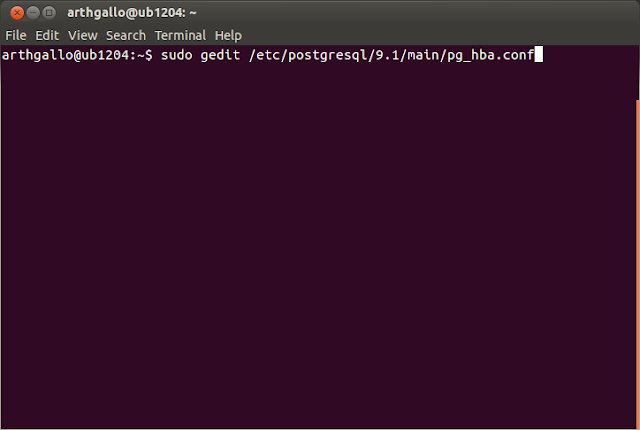I was setting up a new machine with a
fresh postgresql install, and I had just created a new user account.
As I tried to login to psql from the terminal window, I got the
dreaded message informing me that the authentication failed. I
realized, I had not set up my environment to accept local connections
for different users. So in this post, let us see how to do that.
While the steps shown here are for PostgreSQL 9.1, they are valid for 9.3 as well.
We need to edit this file as an administrator, since my user does not have rights to save the file within the etc folder. Hence, we need to use sudo before the gedit command as follows.
> sudo gedit /etc/postgresql/9.1/main/pg_hba.conf
Here,
While the steps shown here are for PostgreSQL 9.1, they are valid for 9.3 as well.
First, the following screen will show
the kind of error I received. Note that the user 'nyadmin' had been
created while logged in as the postgres user. You can also see that I
tried multiple attempts to login before realizing that this was a
fresh installation.
Allowing trusted connections to Postgresql
The file that allows the administrator to manage which users can connect and which cannot, is called pg_hba.conf. I have seen this move around to different locations for different versions of the database, but currently in my environment it was deployed under /etc/postgresql/9.1We need to edit this file as an administrator, since my user does not have rights to save the file within the etc folder. Hence, we need to use sudo before the gedit command as follows.
> sudo gedit /etc/postgresql/9.1/main/pg_hba.conf
We need to edit the file to make
following changes
- Changed postgres authentication to identity from peer
- Changed local authentication to md5 from peer
This means that I will need to become
OS level postgres user to connect to Postgres. Also, locally
connecting users can now enter their passwords to connect the
database.
You can see the changes in the screen
shot below. I commented the previously existing privileges to
highlight the changes.
First, the line....
local all postgres peer
....was commented, with a “#' and the
following line added below it
local all postgres ident
Then, the line....
local all all peer
....was commented, with a “#' and the
following line added below it
local all all md5
With these changes, we can save the
file and close the editor. Next we need to restart the database
service.
Restarting Postgresql service
For restarting the service, we need to
first switch to the postgres OS level user. This can be done by entering .....
> sudo -u postgres service postgresql restart
..... or you can do it in two steps, as shown below.
> sudo -u postgres service postgresql restart
..... or you can do it in two steps, as shown below.
> su – postgres
System will prompt for the postgres
user password, which is postgres by default. Once in, you can issue
the restart command as follows
postgres > service postgresql
restart
Enter command “exit” to come back
to the original prompt. Now enter the command to login as the created
user.
> psql -U nyadmin -d template1 -W
Here,
-U denotes the user,
-d tells the system which database to
connect to. Since I have not yet configured a default database for
this user, I need to explicitly mention template1
-W tells the system that use a
password.
The system prompts for the password,
which I entered, and we are in.
In the next post, we will create a
default database for this user.







No comments:
Post a Comment